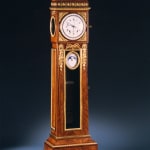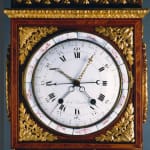Jean-Simon Bourdier
Further images
Provenance
F de Paniagua Collection, sold at Hôtel Drout, Paris, 4th May 1983, lot 124.
Exhibitions
Ferdinand Berthoud, “Essai sur l’Horlogerie”, 1763 ed, vol. II, p. 138, describing the pendulum used in this regulator. Tardy, “La Pendule Française”, 1949, vol. II, p. 161, illustrating a similar clock with case by Lieutaud in the Victoria and Albert Museum, London, with the exact same gilt bronze figure of Father Time, and p. 210 and 211, illustrating a similar Coteau moon phase dial. Peter Hughes, “The Wallace Collection Catalogue of Furniture”, 1996, pp. 444-451, F271, describing and illustrating a similar clock with case by Lieutaud in the Wallace Collection, London. C. Frégnac and J. Meuvret, “French Cabinetmakers of the Eighteenth Century”, 1965, p. 202, illustrating a similar clock with case by Lieutaud in the Musée de Versailles. T. Dell, “Furniture in the Frick Collection”, 1992, p. 317, illustrating a similar clock with case by Lieutaud and p. 328, describing the present clock.
Literature
T. Dell, et. al., The Frick Collection, An Illustrated Catalogue, V Furniture, 1992, p. 328.
A rare and highly important Louis XVI gilt bronze mounted long case regulator of long duration by Jean-Simon Bourdier (d. 1839), housed in a magnificent case by Balthazar Lieutaud (b. circa 1720 d. 1780), with superb gilt bronze mounts attributed to Philippe Caffiéri (1714-74) and exquisite painted dials by Joseph Coteau (1740-1812). The main dial signed J. S. Bourdier with an inner seconds ring and Roman and Arabic hour and minute numerals and outer calendar rings for the names of the month and their symbols and numbers of days in each month with a very fine pair of pierced gilt brass hands for the hours and minutes and blued steel pointers for the seconds, equation minutes and calendar indications. Below the main dial heading the pendulum aperture an exquisite oval lunar dial signed Coteau and inscribed ‘Phases de la Lune & Quantieme du Mois’ showing the gold and white painted moon against a gilt star-studded blue sky marked above with the 29 ½ days of the lunar month with an outer ring marked with the 31 days of the month, each within a gilded frame interspersed by polychrome jewels, framed above and below by floral arabesques and centred above by a satyr mask. The weight driven movement with Graham anchor escapement, knife-edge suspension with a nine-rod steel and brass compensated pendulum mounted with a temperature scale enamelled by Coteau, with fine beat adjustment to the crutch, the indications for the equation of time, days of the month and signs of the zodiac all powered by the striking mechanism, the strike powered by a massive spring barrel, striking on the hour and half hours on a single bell with a very large outside count wheel with cut-out grooves for each day and taking 24 hours for each complete rotation. The superb Neo-classical amaranth, rosewood and boxwood case of rectangular form, surmounted by Father Time holding an hour glass and scythe and reclining on billowing clouds mounted below by a guilloche border, the main dial flanked by oak leaf spandrels with oval frames to either side, mounted below by a laurel leaf frame enclosing the lunar dial flanked either side by foliate sprays enclosing geographical symbols
Paris, date circa 1785
JEAN-SIMON BOURDIER (c. 1760-1839)
One of the most innovative clockmakers of his time, Jean-Simon Bourdier became a maitre horloger in Paris on 22 September 1787. He is recorded as working in the rue des Precheurs in 1787, quai de 1'Horloge du Palais circa 1790, rue Mazarine in 1801, rue Saint-Saveur in 1812 and rue Saint-Denis in 1830. He gained a silver medal in the 1806 and 1879 produits de I'industrie exhibitions.
He is known to have worked with the ebenistes Lieutaud and Riesener as well as the bronziers Galle, Thomire and Remond. his dials were painted by the emailleurs Dubuisson and Coteau. His clocks were also sold by the dealers Daguerre and Lignereux and Juilliot.
BALTHAZAR. LIEUTAUD (circa 1720-1780) Balthazar Lieutaud became a maitre in 1749. The son of the ebeniste Charles Lieutaud and grandson of Francois Lieutaud an ebeniste from Marseilles, he specialized in clockcases. He worked with the bronziers Philippe Caffieri, Charles Grirnpelle and Edme Roye. By 1750 he was installed in rue de la Pelleterie on the ile de la cite, the clockmakers' district and moved to the rue d'Enfer in 1772. Following his death in 1780, his wife, Nicole Godard (1721-1800), continued to run the atelier. The atelier was presumably still active at least up until 1786 as Louis Berthoud's account book lists a payment to the widow on 27 April 1786.
JOSEPH COTEAU (1740-1801). FRENCH
Painted enamel and porcelain dials became increasingly popular during the reign of Louis XVI, reaching perfection in the hands of Joseph Coteau and Gobin Etienne (known as Dubuisson). Coteau was born in Geneva, Switzerland but is known to have practised his specialised craft in Paris. During his maturity he was established at Rue Toupee in the parish of Sant-Andre-des-Arts, where he remained until his death. At the age of 23 he produced the dial for a musical clock by Daille, horologer to Madame la Dauphine, 1763(Wallace Collection, London). Coteau attained such repute that he only ever supplied to the most eminent horologists, including Antide Janvier (1751-1835), Robert Robin (1742-1809) and Ferdinand Berthoud (1727-1807). He is also known to have decorated pieces of jewellery.
Coteau clock dials have a characteristic style, due as much to their superior quality as to their subject. His most distinct decoration consisted of delicate numerals with small garlands of flowers but more usually with signs of the zodiac, each element worked as an individual miniature. Other dials had little or no extra ornament except for the classical Louis XVI style numerals, such as his dial for the Avignon Clock, 1771 (Wallace Collection, London), with the movement by Delunesy and elaborate gilt bronze case sculptured by Louis-Simon Boizot (1743-1809) and executed by Pierre Gouthiere (1732-C.1812). At other times Coteau supplied decorative bands to accompany clock cases, such as an enamel frieze around a vase adorning one of Robert Robin's elaborate clocks, c.1780 (Wallace Collection, London). The band, painted in grisaille, depicts the seasons personified by infants playing and is interspersed by four cameo heads. A similar clock was supplied to Marie Antoinette for Chateau St. Cloud. Decorative dials and their accompanying complex quality movements fell in demand during the Revolution, however Coteau was patronised by the new government to create a number of Republican ten hour dials.
It appears that Coteau never enamelled watches or small scale pieces but specialised in larger works, which were technically more complex due to shrinkage during firing. The techniques required a high degree of skill to achieve a perfect finish. Coteau experimented with various polychromes, producing a blue that was so rare and complex that few if any of his contemporaries managed to copy. The enamel paint was applied with a brush onto a copper plate and the various colours vitrified one by one in a muffle kiln. The decoration was then enhanced by delicate gilding, which after firing resulted in a matt finish, the gilding was finally burnished to restore its metallic brightness.
Coteau dials are extremly rare, they are sometimes "secretly" inscribed on the reverse, in either pen or bruch. In addition to their scarcity and their supreme quality, his dials and enamel plaques only accompanied the most complex quality mechanisms. For these reasons his work is a tru prize and significantly enhances the value of any clock. Examples of his work can be found in a number of European museums, including Mobilier National, Musee des Arts Decoratifs, Paris; Carnavelet Museum, Dijon Museum, and in London at the Wallace Collection and Victoria and Albert Museum.
Copyright by Richard Redding , Zurich, all rights reserved.





